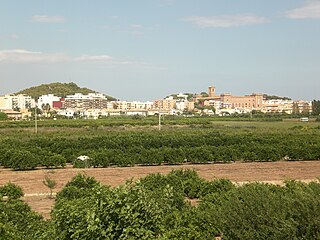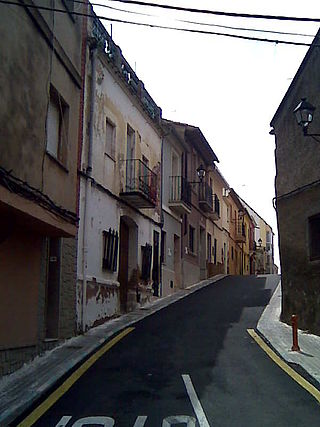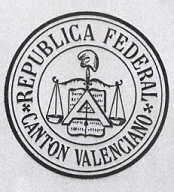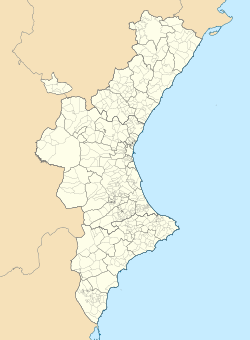
The Fallas is a traditional celebration held annually in commemoration of Saint Joseph in the city of Valencia, Spain. The five main days celebrated are from 15 to 19 March, while the Mascletà, a pyrotechnic spectacle of firecracker detonation, takes place every day from 1 to 19 March. The term Fallas refers to both the celebration and the Falla monuments burnt during the celebration. A number of towns in the Valencian Community have similar celebrations inspired by the original Fallas de Valencia celebration. For example, the bonfires of Alicante or the Fiestas de la Magdalena in Castellón de la Plana. The Fallas festival was added to UNESCO's intangible cultural heritage of humanity list on 30 November 2016.

Valencia is the capital of the province and autonomous community of the same name in Spain. It is the third-most populated municipality in the country, with 807,693 inhabitants (2023). 2,522,383 inhabitants live within the metropolitan area. It is located on the banks of the Turia, on the east coast of the Iberian Peninsula on the Mediterranean Sea.

Alboraya or Alboraia is a town and municipality of the province of Valencia, Spain. It is situated very close to the city of Valencia.

Horta Nord is a comarca in the province of Valencia, Valencian Community, Spain.

El Puig, officially El Puig de Santa Maria since 2012, is a village situated 15 km north of the city of Valencia in the comarca of Horta Nord, Spain. Its name means "hill" in Valencian). The municipality comprises three main areas, the first being the village itself, which is dominated by a monastery, and two large wooded hills next to it, the largest of which has the ruins of a castle fortress at the top. Originally, however, there was another hill named La Pedrera which disappeared gradually during the 20th century to make way for the V-21 motorway, with the rock being used to construct one of the jetties at Valencia's port. The second section is the coastal area of 4 km of beach with eight housing developments that are generally only inhabited in the summer; and finally, there is an industrial park located between them.

Alaquàs is a municipality in the Horta Oest comarca in the Valencian Community.
Alfara del Patriarca is a municipality in the comarca of Horta Nord in the Valencian Community, Spain.
Bétera is a municipality in the comarca of Camp de Túria in the Valencian Community, Spain. With 23,647 inhabitants, it is the second most populous town in the Camp de Túria shire, in the second zone of the Valencia metropolitan area.

Foios is a municipality in the comarca of Horta Nord in the Valencian Community, Spain. It has a population of 7,342.

Náquera is a municipality in the region (comarca) of Camp de Túria in the Valencian Community, Spain; placed in the NE of the province of Valencia at a distance of 24 km from Valencia. The main church is Nuestra Señora de la Encarnación.

Paterna is a city and a municipality in the province of Valencia in the Valencian Community, Spain. It is located northeast of the comarca of L'Horta de Valencia, 5 kilometres northwest of the inland suburbs of Valencia, and on the left bank of the river Turia. Its population in 2014 was 67,156 inhabitants, being the eleventh city by population in the Valencian Community.

Puçol is a Spanish municipality located in the province of Valencia, part of the Valencian Community autonomous region. It belongs to the Horta Nord. The municipality borders El Puig south and Sagunt to the north. It has 19,975 inhabitants (01/01/2021), of whom 9,839 are men and 10,136 are women.

Quart de Poblet is a municipality in the comarca of Horta Oest in the Valencian Community, Spain. It has 25,499 inhabitants.

Valencians are the native people of the Valencian Community, in eastern Spain. Legally, Valencians are the inhabitants of the community. Since 2006, the Valencian people are officially recognised in the Valencian Statute of Autonomy as a nationality "within the unity of the Spanish nation". The official languages of Valencia are Valencian and Spanish.
Manuel Palau Boix was a Spanish composer and teacher in Valencia Conservatory. He wrote a large number of symphonic, band, choral and chamber works. He was one of the most popular and important composers of his time. He received the Spanish National Music Award twice, first in 1927 and again in 1945. His music is known within the Spanish classical music for being a representative of what it has been called “Mediterranean” style, like other Spanish musicians such as Vicente Asencio or Oscar Esplá.

The Carraixet ravine is a course of water from the north of the Valencian province, in the Valencian Community (Spain). It begins in Gátova and collects waters from the sloped southern side of the Calderona mountain range. It flows into the Mediterranean Sea through the town of Alboraya. At its mouth, it is also called the Olocau ravine or the Peralvillo ravine. In the Book of the Facts James I named it riu Sec, while discussing the Battle of the Puig.

The Ojos Negros Greenway, is a 160-kilometre greenway in Spain running between the village of Santa Eulalia del Campo in the province of Teruel in Aragón and the village of Algimia d'Alfara, in the province of Valencia in the Valencian Community.

Pobles del Nord is the 17th district of the city of Valencia (Spain). It is composed of seven towns, which were annexed to Valencia between 1888 and 1900, which are today considered neighborhoods: Benifaraig, Pueblo Nuevo, Carpesa, Casas de Bárcena, Mahuella, Tauladella, Rafalell i Vistabella, Masarrochos and Borbotó.

The Valencian Canton, also known as the Canton of Valencia, was one of the first independent cantons proclaimed during the Cantonal rebellion that took place during the First Spanish Republic (1873-1874). It was officially proclaimed on July 18, 1873, and 178 municipalities of the Valencia province adhered to it. It fell on August 8, when the troops of Martínez Campos, sent by the federal republican government of Nicolás Salmerón, entered the city of Valencia, causing the surrender of the Canton.

Benifaraig is a pedania of the city of Valencia (Spain), belonging to the district of Poblados del Norte. It is bordered on the west by Godella, on the east by Alfara del Patriarca, on the north by Moncada and on the south by Borbotó and Carpesa. Its census population in 2022 was 993 inhabitants. It was an independent municipality until 1900, when it became a pedania of the city of Valencia.
























